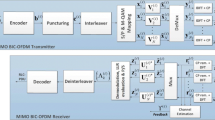Abstract
In this paper, we analyze the effect of channel estimation error and delayed feedback on the performance of a cross-layer scheme combining adaptive modulation for maximum ratio transmission (MRT) at the physical layer and truncated automatic repeat request (T-ARQ) at the link layer. The cross-layer attempts to maximize the spectral efficiency under predetermined quality of service requirements, namely, delay and packet-loss constraints. In particular, we derive closed-form expressions for the average packet error rate, average achievable spectral efficiency, and the outage probability, hence, enabling to evaluate the performance of the cross-layer scheme in the presence of imperfect channel estimation at the receiver and delayed feedback path between the receiver and transmitter. The final expressions are given in terms of the minimum and maximum number of transceiver antennas as well as the channel estimation error and feedback delay parameters. We further show that with a small amount of channel estimation error and/or feedback delay the system performance is severely degraded. Specifically, numerical results demonstrate that with channel estimation error and feedback delay the performance of the cross-layer scheme is even worse than that of T-ARQ only. We also observe an irreducible outage probability floor appearing in the high signal-to-noise regime.
Similar content being viewed by others
References
Webb W. T., Steele R. (1995) Variable rate QAM for mobile radio. IEEE Transactions on Communications COM-43: 2223–2230
Goldsmith A. J., Chua S. -G. (1997) Variable-rate variable-power MQAM for fading channels. IEEE Transactions on Communications 45(10): 1218–1230
Goldsmith A. J., Chua S. -G. (1998) Adaptive coded modulation for fading channels. IEEE Transactions on Communications 46(5): 595–602
Alouini M.-S., Tang X., Goldsmith A. J. (1999) An adaptive modulation scheme for simultaneous voice and data transmission over fading channels. IEEE Journal of Selected Areas in Communications 17(5): 337–350
Alouini M.-S., Goldsmith A. J. (2000) Adaptive modulation over Nakagami fading channels. Wireless Personal Communications 13(1–2): 119–143
Malkamaki E., Leib H. (2000) Performance of truncated type-II hybrid ARQ schemes with noisy feedback over block fading channels. IEEE Transactions on Communications 48(9): 1477–1487
Liu Q., Zhou S., Giannakis G. B. (2004) Cross-layer combining of adaptive modulation and coding with truncated ARQ over wireless links. IEEE Transactions on Wireless Communications 3(5): 1746–1755
Maaref, A., & Aïssa, S. (2004a). A cross-layer design for MIMO Rayleigh fading channels. In Proceedings of the electrical and computer engineering Canadian conference. Ontario, Canada, pp. 2247–2250.
Maaref, A., & Aïssa, S. (2004b). Combined adaptive modulation and truncated ARQ for packet data transmission in MIMO systems. In Proceedings of the IEEE global commununications Conference. Dallas, USA, pp. 3818–3822.
Maaref, A., & Aïssa, S. (2005). Cross-layer design for MIMO Nakagami fading channels in the presence of Gaussian channel estimation errors. In Proceedings of the electrical and computer engineering Canadian Conference. Saskatoon, Canada, pp. 1380–1383.
Dighe P. A., Mallik R. K., Jamuar S. S. (2003) Analysis of transmit-receive diversity in Rayleigh fading. IEEE Transactions on Communications 4(51): 694–703
Dighe P. A., Mallik R. K., Jamuar S. S. (2003) Analysis of K transmit dual-receive diversity with cochannel interferers over a Rayleigh fading channel. Wireless Personal Communications 25(2): 87–100
Lo T. K. Y. (1999) Maximum ratio transmission. IEEE Transactions on Communications 47(10): 1458–1461
Chen Y., Tellambura C. (2005) Performance analysis of maximum ratio transmission with imperfect channel estimation. IEEE Communications Letters 9(4): 322–324
Yoo T., Goldsmith A. (2006) Capacity and power allocation for fading MIMO channels with channel estimation error. IEEE Transactions on Information Theory 52(5): 2203–2214
Au E. K. S., Jin S., McKay M. R., Mow W. H., Gao X., Collings I. B. (2008) Analytical performance of MIMO-SVD systems in Ricean fading channels with channel estimation error and feedback delay. IEEE Transactions on Wireless Communications 7(4): 1315–1325
Khatri C. G. (1964) Distribution of the largest or the smallest characteristic root under null hyperthesis concerning complex multivariate normal populations. Annals of Mathematical Statistics 35: 1807–1810
Gradshteyn I. S., Ryzhik I. M. (2000) Table of integrals, series, and products (6th ed.). Academic Press, San Diego
Maaref A., Aïssa S. (2005) Closed-form expressions for the outage and ergodic Shannon capacity of MIMO MRC systems. IEEE Transactions on Communications 53(7): 1092–1095
Jakes W. C. (1994) Microwave mobile communication (2nd ed.). IEEE Press, Piscatawa
Author information
Authors and Affiliations
Corresponding author
Rights and permissions
About this article
Cite this article
Duong, T.Q., Zepernick, HJ. Cross-Layer Design for MRT Systems with Channel Estimation Error and Feedback Delay. Wireless Pers Commun 58, 681–694 (2011). https://doi.org/10.1007/s11277-009-9901-2
Published:
Issue Date:
DOI: https://doi.org/10.1007/s11277-009-9901-2




